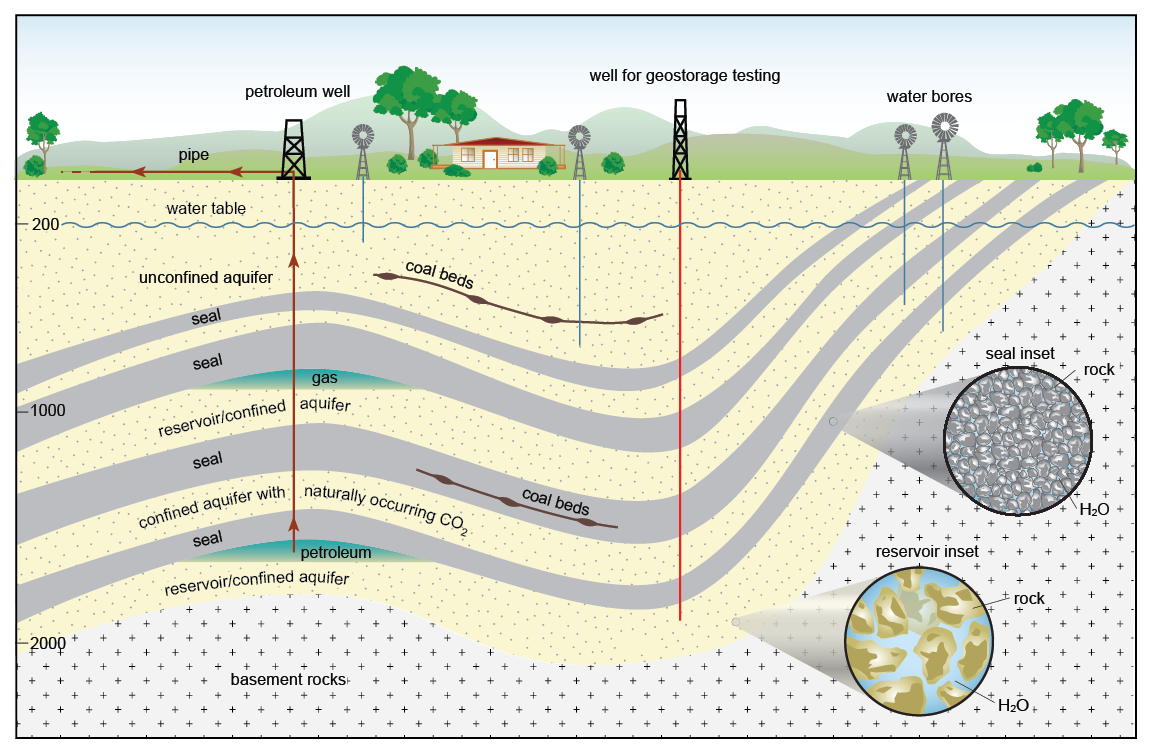About greenhouse gas storage
In Queensland, greenhouse gas (GHG) storage refers to the geological storage of captured carbon dioxide (CO2). CO2 is typically produced from the use of fossil fuels in electricity generation and industrial processes. CO2 may also be captured from bio-based processes, and directly from the atmosphere via direct air capture. The process of capturing CO2 and placing it in geological storage is also referred to as carbon capture and storage (CCS).
A company that wants to explore for GHG storage sites and eventually inject CO2 must first apply for a greenhouse gas exploration permit and an environmental authority. Any native title requirements will also need to be addressed before an exploration permit is granted.
In Queensland, GHG storage activities are prohibited within the area of the Great Artesian Basin, that is the area on or below the surface of the plan area under the Water Plan (Great Artesian Basin and Other Regional Aquifers) 2017 (PDF, 1.2MB).
The Queensland Government manages competitive tendering for greenhouse gas storage exploration. Find out about the Queensland exploration program and current tender opportunities.
Carbon capture and storage process
Although each carbon capture and storage project is unique, CCS projects typically include the following steps:
- A source of CO2 is identified, such as an industrial facility or power station.
- CO2 is captured from its source and separated from other gases or contaminants.
- CO2 is cooled and compressed into a liquid in advance of transporting.
- Compressed CO2 is transported to the storage site via pipeline or truck.
- CO2 is injected through a well into deep underground geological formations at depths of 800 metres or more. It is permanently trapped by:
- geological storage—using surrounding solid rock to stop the gas from moving out of the formation
- using water in the formation to absorb the CO2
- mineralisation—using coal or other compounds in the rock to bind the CO2.
- The migration pathways of greenhouse gas streams are monitored before, during and after injection into the relevant GHG storage reservoir.
Underground reservoirs and aquifers
GHG storage exploration is similar to petroleum and gas exploration because both involve exploration for a suitable geological reservoir.
Crude oil and natural gas, including CO2-rich waters, are stored naturally underground, where they are trapped in deep reservoirs. These reservoirs are porous geological formations that are capped by an impermeable layer of rock, which acts as a seal.
Figure 1: Vertical cross-section of ground layers showing where gas, petroleum, coal and groundwater can be found. Insets compare reservoir and seal composition.
Sediments accumulate to form successive layers of rock with varying permeabilities that overlay an impermeable hard-rock geological basement.
Highly porous and permeable layers can store hydrocarbons and/or water and are referred to as reservoirs or aquifers, respectively. Layers of lower permeability (usually with smaller grain and pore sizes) seal the reservoirs and aquifers, preventing the loss of hydrocarbons and/or mixing of groundwaters.
Sedimentary basins hold resources that are often targeted for a variety of activities (i.e. extraction of hydrocarbons, coal and water), all taking place within a small area but at different depths. Water extraction, for instance, can occur at very shallow depths from unconfined (unsealed) aquifers or from greater depths from confined (sealed) aquifers.
What happens if a suitable reservoir is found
If a potentially suitable reservoir for CO2 storage is found during the exploration phase, the exploration permit holders will need to apply for a greenhouse gas injection and storage lease and secure the required environmental approvals before any pilot or commercial scale storage of CO2 is undertaken.
Also consider...
- Read our guide to the application process for resource authorities for general information about lodging an application.
- Find out how to comply with your resource authority and the land access code.